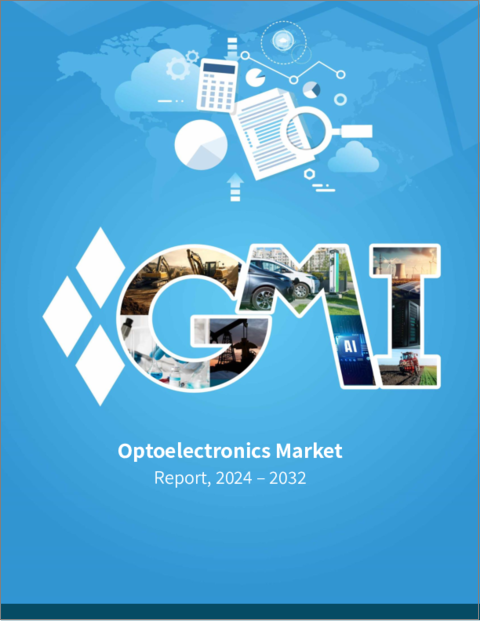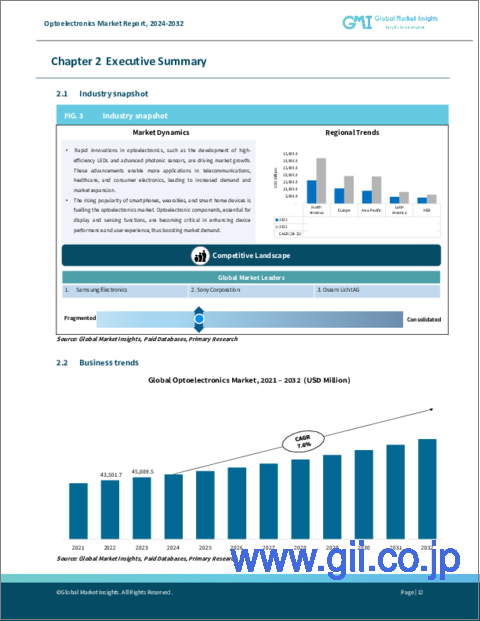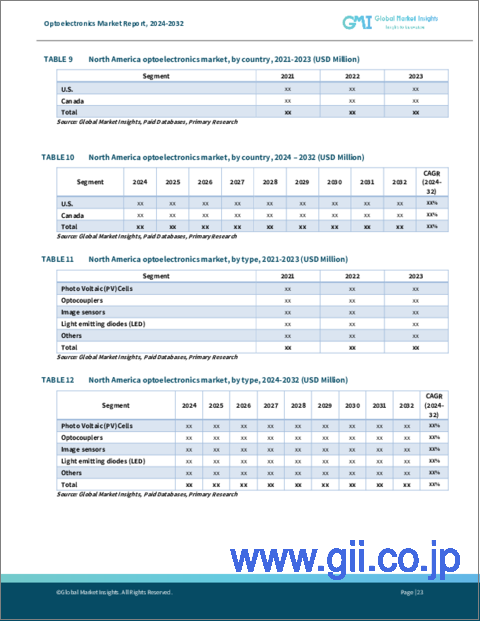|
|
市場調査レポート
商品コード
1535681
オプトエレクトロニクス市場:タイプ別、最終用途別、産業別、予測、2024年~2032年Optoelectronics Market - By Type (Photo Voltaic (PV) Cells, Optocouplers, Image Sensors, Light Emitting Diodes (LED)), By End Use (Residential & Commercial, Industrial), By Industry & Forecast, 2024 - 2032 |
||||||
カスタマイズ可能
|
|||||||
| オプトエレクトロニクス市場:タイプ別、最終用途別、産業別、予測、2024年~2032年 |
|
出版日: 2024年06月13日
発行: Global Market Insights Inc.
ページ情報: 英文 220 Pages
納期: 2~3営業日
|
- 全表示
- 概要
- 目次
オプトエレクトロニクスの世界市場は、2024年から2032年にかけてCAGR 7%超を示す、自動車産業におけるイノベーションが背景にあります。
ADAS(先進運転支援システム)や自律走行車は、オプトエレクトロニクス部品を利用して安全性と運転効率を高めています。これらのシステムは、センサ、カメラ、ライダに依存しており、正確なデータ収集と処理にはオプトエレクトロニクスイノベーションに依存しています。一例を挙げると、2023年 4月、Bosch Sensortecは車載ADASアプリケーションをターゲットとしたBMA490LとBMI323センサーを発表しました。加速度計とジャイロスコープを統合したBMA490L加速度センサとBMI323センサは、先進自動車安全システムに不可欠な環境認識と運転支援を強化します。
データ伝送、画像システム、ディスプレイ技術などのアプリケーションでオプトエレクトロニクスの採用が増加しており、高速通信やスマート技術へのニーズの高まりと相まって、市場拡大の原動力となっています。さらに、光センサの進歩や、拡張現実や自律走行車などの新技術へのオプトエレクトロニクスデバイスの統合が、業界の展望を形成しています。
オプトエレクトロニクス市場は、タイプ、最終用途、地域に基づいてグループ化されています。
オプトカプラセグメントは、電子システムの信頼性と安全性を高める上で重要な役割を果たすため、2032年まで注目すべきCAGRを記録します。オプトカプラは、異なる回路セクション間に必要不可欠な絶縁を提供し、信号干渉を防ぎ、高電圧から敏感なコンポーネントを保護します。電子機器の複雑化と集積化に伴い、通信システム、電源、産業オートメーションにおける信頼性の高い絶縁の必要性が高まり、オプトカプラの需要を押し上げています。
産業用セグメントは、2032年までに大きな市場シェアを獲得すると見られており、これは製造プロセスにおける高度な自動化と高精度の組み込みが原動力となっています。オプトエレクトロニクスコンポーネントは、プロセス制御、モニタリング、データ収集システムの強化に不可欠です。産業界は、生産ラインの作業効率、信頼性、安全性を向上させるために、これらの技術を採用しています。産業界がパフォーマンスを最適化し、ダウンタイムを削減しようとする中で、リアルタイムモニタリング、品質管理、予知保全などの高度なアプリケーションをサポートするオプトエレクトロニクスの統合が広がっています。
欧州オプトエレクトロニクス市場は、先端製造と技術革新への投資増加により、予測期間中に注目すべきCAGRを記録します。同地域は、デジタルトランスフォーメーションと自動化に注力しており、スマートインフラから先進交通システムまで、様々なアプリケーションでオプトエレクトロニクスコンポーネントへのニーズが高まっています。さらに、持続可能性とエネルギー効率への取り組みが、環境モニタリングや再生可能エネルギーソリューションでの技術採用を後押ししています。接続性の向上と洗練された技術の統合が重視されるようになり、欧州での業界拡大が刺激されています。
目次
第1章 調査手法と調査範囲
第2章 エグゼクティブサマリー
第3章 業界洞察
- エコシステム分析
- ベンダー・マトリックス
- 利益率分析
- テクノロジーとイノベーションの展望
- 特許分析
- 主要ニュースと取り組み
- 規制状況
- 影響要因
- 促進要因
- コンシューマー・エレクトロニクスの需要増加
- 通信インフラの拡大
- 自動車技術の進歩
- 再生可能エネルギーの推進
- スマートテクノロジーの出現
- 業界の潜在的リスク&課題
- 高い初期投資コスト
- 複雑な製造工程と品質管理
- 促進要因
- 成長可能性分析
- ポーター分析
- PESTEL分析
第4章 競合情勢
- イントロダクション
- 企業シェア分析
- 競合のポジショニング・マトリックス
- 戦略展望マトリックス
第5章 市場推計・予測:タイプ別、2021年~2032年
- 主要動向
- 太陽電池
- オプトカプラ
- イメージセンサー
- 発光ダイオード(LED)
- その他
第6章 市場推計・予測:最終用途別、2021年~2032年
- 主要動向
- 住宅・商業
- 産業
第7章 市場推計・予測:産業別、2021年~2032年
- 主要動向
- 自動車
- 航空宇宙・防衛
- 家電
- 情報技術
- ヘルスケア
- その他
第8章 市場推計・予測:地域別、2021年~2032年
- 主要動向
- 北米
- 米国
- カナダ
- 欧州
- 英国
- ドイツ
- フランス
- イタリア
- スペイン
- その他欧州
- アジア太平洋
- 中国
- インド
- 日本
- 韓国
- ニュージーランド
- その他アジア太平洋地域
- ラテンアメリカ
- ブラジル
- メキシコ
- その他ラテンアメリカ
- 中東・アフリカ
- UAE
- 南アフリカ
- サウジアラビア
- その他中東・アフリカ
第9章 企業プロファイル
- Avago Technologies
- Broadcom Inc.
- Coherent Inc
- Cree Inc.
- Epistar Corporation
- Finisar Corporation
- Hamamatsu Photonics
- Kyocera Corporation
- LG Innotek
- Lumileds
- Luminit
- NeoPhotonics Corporation
- Nichia Corporation
- ON Semiconductor
- Osram Licht AG
- Panasonic Corporation
- Renesas Electronics
- Rohm Semiconductor
- Samsung Electronics
- Sharp Corporation
- Sony Corporation
- STMicroelectronics
- Texas Instruments
- Toshiba Corporation
- Vishay Intertechnology
Global Optoelectronics Market will show over 7% CAGR from 2024 to 2032, backed by innovations in the automotive industry. Advanced driver-assistance systems (ADAS) and autonomous vehicles utilize optoelectronic components to enhance safety and driving efficiency. These systems rely on sensors, cameras, and lidar, which depend on optoelectronic innovations for accurate data collection and processing. Quoting an instance, in April 2023, Bosch Sensortec unveiled the BMA490L and BMI323 sensors, targeting automotive ADAS applications. The BMA490L accelerometer and BMI323 sensor, integrating accelerometer and gyroscope, enhance environmental perception and driver assistance, crucial for advanced vehicle safety systems.
The increasing adoption of optoelectronics in applications like data transmission, imaging systems, and display technologies, combined with the rising need for high-speed communication and smart technologies, fuels market expansion. Additionally, advancements in optical sensors and the integration of optoelectronic devices in emerging technologies, such as augmented reality and autonomous vehicles, is shaping the industry outlook.
The optoelectronics market is grouped based on type, end-use, and region.
The optocouplers segment will register a notable CAGR through 2032, owing to their critical role in enhancing electronic system reliability and safety. Optocouplers provide essential isolation between different circuit sections, preventing signal interference and protecting sensitive components from high voltages. As electronic devices become more complex and integrated, the need for reliable isolation in communication systems, power supplies, and industrial automation increases, boosting the demand for optocouplers.
The industrial segment will garner a significant market share by 2032, driven by the incorporation of advanced automation and precision in manufacturing processes. Optoelectronic components are essential for enhancing process control, monitoring, and data acquisition systems. Industries are adopting these technologies to improve operational efficiency, reliability, and safety in their production lines. As industries seek to optimize performance and reduce downtime, there is wider integration of optoelectronics to support sophisticated applications such as real-time monitoring, quality control, and predictive maintenance.
Europe optoelectronics market will record a noteworthy CAGR during the forecast period, due to increased investments in advanced manufacturing and technological innovation. The region's focus on digital transformation and automation drives the need for optoelectronic components in various applications, from smart infrastructure to advanced transportation systems. Additionally, the commitment to sustainability and energy efficiency is propelling the technology adoption in environmental monitoring and renewable energy solutions. The growing emphasis on enhancing connectivity and integrating sophisticated technologies stimulates the industry expansion in Europe.
Table of Contents
Chapter 1 Methodology & Scope
- 1.1 Market scope & definition
- 1.2 Base estimates & calculations
- 1.3 Forecast calculation
- 1.4 Data sources
- 1.4.1 Primary
- 1.4.2 Secondary
- 1.4.2.1 Paid sources
- 1.4.2.2 Public sources
Chapter 2 Executive Summary
- 2.1 Industry 360º synopsis, 2021 - 2032
Chapter 3 Industry Insights
- 3.1 Industry ecosystem analysis
- 3.2 Vendor matrix
- 3.3 Profit margin analysis
- 3.4 Technology & innovation landscape
- 3.5 Patent analysis
- 3.6 Key news and initiatives
- 3.7 Regulatory landscape
- 3.8 Impact forces
- 3.8.1 Growth drivers
- 3.8.1.1 Rising demand for consumer electronics
- 3.8.1.2 Expansion of telecommunications infrastructure
- 3.8.1.3 Advancements in automotive technology
- 3.8.1.4 Push for renewable energy
- 3.8.1.5 Emergence of smart technologies
- 3.8.2 Industry pitfalls & challenges
- 3.8.2.1 High initial investment costs
- 3.8.2.2 Complex manufacturing processes and quality control
- 3.8.1 Growth drivers
- 3.9 Growth potential analysis
- 3.10 Porter's analysis
- 3.10.1 Supplier power
- 3.10.2 Buyer power
- 3.10.3 Threat of new entrants
- 3.10.4 Threat of substitutes
- 3.10.5 Industry rivalry
- 3.11 PESTEL analysis
Chapter 4 Competitive Landscape, 2023
- 4.1 Introduction
- 4.2 Company market share analysis
- 4.3 Competitive positioning matrix
- 4.4 Strategic outlook matrix
Chapter 5 Market Estimates & Forecast, By Type, 2021 - 2032 (USD Million)
- 5.1 Key trends
- 5.2 Photovoltaic (PV) cells
- 5.3 Optocouplers
- 5.4 Image sensors
- 5.5 Light-emitting Diodes (LED)
- 5.6 Others
Chapter 6 Market Estimates & Forecast, By End Use, 2021 - 2032 (USD Million)
- 6.1 Key trends
- 6.2 Residential & commercial
- 6.3 Industrial
Chapter 7 Market Estimates & Forecast, By Industry, 2021 - 2032 (USD Million)
- 7.1 Key trends
- 7.2 Automotive
- 7.3 Aerospace & defense
- 7.4 Consumer electronics
- 7.5 Information technology
- 7.6 Healthcare
- 7.7 Others
Chapter 8 Market Estimates & Forecast, By Region, 2021 - 2032 (USD Million)
- 8.1 Key trends
- 8.2 North America
- 8.2.1 U.S.
- 8.2.2 Canada
- 8.3 Europe
- 8.3.1 UK
- 8.3.2 Germany
- 8.3.3 France
- 8.3.4 Italy
- 8.3.5 Spain
- 8.3.6 Rest of Europe
- 8.4 Asia Pacific
- 8.4.1 China
- 8.4.2 India
- 8.4.3 Japan
- 8.4.4 South Korea
- 8.4.5 ANZ
- 8.4.6 Rest of Asia Pacific
- 8.5 Latin America
- 8.5.1 Brazil
- 8.5.2 Mexico
- 8.5.3 Rest of Latin America
- 8.6 MEA
- 8.6.1 UAE
- 8.6.2 South Africa
- 8.6.3 Saudi Arabia
- 8.6.4 Rest of MEA
Chapter 9 Company Profiles
- 9.1 Avago Technologies
- 9.2 Broadcom Inc.
- 9.3 Coherent Inc
- 9.4 Cree Inc.
- 9.5 Epistar Corporation
- 9.6 Finisar Corporation
- 9.7 Hamamatsu Photonics
- 9.8 Kyocera Corporation
- 9.9 LG Innotek
- 9.10 Lumileds
- 9.11 Luminit
- 9.12 NeoPhotonics Corporation
- 9.13 Nichia Corporation
- 9.14 ON Semiconductor
- 9.15 Osram Licht AG
- 9.16 Panasonic Corporation
- 9.17 Renesas Electronics
- 9.18 Rohm Semiconductor
- 9.19 Samsung Electronics
- 9.20 Sharp Corporation
- 9.21 Sony Corporation
- 9.22 STMicroelectronics
- 9.23 Texas Instruments
- 9.24 Toshiba Corporation
- 9.25 Vishay Intertechnology





